

Social intelligence. Social Intelligence Lab. Odis. L'émotion au service de la logique. L'intelligence émotionelle face à l'intelligence prédatrice. J’ai l’intime conviction, solidement appuyée sur de récentes découvertes des neuro-sciences modernes, que nous avons appliqué de manière trop systématique et surtout dogmatique, certains concepts issus des philosophies des Lumières sans se poser les questions essentielles de leur validité en relation à la constante nécessité de l’adaptation des hommes à l’évolution de leur environnement.
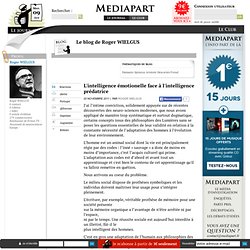
L’homme est un animal social dont la vie est principalement régie par des codes : l’inné « sauvage » a donc de moins en moins d’importance, c’est l’acquis culturel qui prime. L’adaptation aux codes est d’abord et avant tout un apprentissage et c'est bien le contenu de cet apprentissage qu'il va falloir remettre en quétion. Nous arrivons au coeur du problème. Le milieu social dispose de prothèses symboliques et les individus doivent maîtriser leur usage pour s’intégrer pleinement. C’est en gros une adaptation de l’humain aux philosophies des Lumières. Je m’explique : Elle est partout autour de nous. 8 Forms Of Intelligence, Quiz, Trivia, Interesting Facts. Theory of multiple intelligences.
The theory of multiple intelligences is a theory of intelligence that differentiates it into specific (primarily sensory) "modalities", rather than seeing intelligence as dominated by a single general ability.
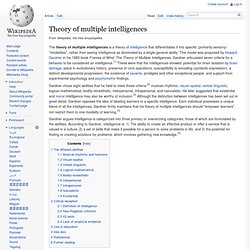
This model was proposed by Howard Gardner in his 1983 book Frames of Mind: The Theory of Multiple Intelligences. Gardner articulated seven criteria for a behavior to be considered an intelligence.[1] These were that the intelligences showed: potential for brain isolation by brain damage, place in evolutionary history, presence of core operations, susceptibility to encoding (symbolic expression), a distinct developmental progression, the existence of savants, prodigies and other exceptional people, and support from experimental psychology and psychometric findings.
Gardner argues intelligence is categorized into three primary or overarching categories, those of which are formulated by the abilities. The different abilities[edit] Musical–rhythmic and harmonic[edit] Intelligences Multiples. LA_THEORIE_DES_INTELLIGENCES_MULTIPLES_Howard_Gardner.pdf (Objet application/pdf) Taxonomie des I.M. Cet essai prend racine dans les travaux de Gardner et constitue, en quelque sorte, une forme de prolongement des conditions qu’il pose à chaque intelligence candidate.
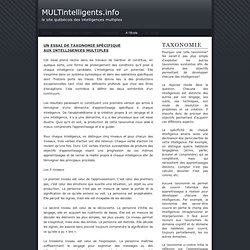
L’intelligence est un potentiel. Elle s’exprime dans un système symbolique et dans des opérations spécifiques dont l’histoire porte les traces. Elle donne lieu à des productions exceptionnelles tant chez des déficients profonds que chez des êtres d’exceptions. Cela contribue à définir les deux extrémités d’un continuum. BILINGUAL GLOSSARY OF MULTIDIMENSIONAL QUALIFIERS OF INTELLIGENCE. - Designates the cognitive abilities of a community as a result of multiple interactions between members, or agents, - This is a constitutive phenomenon of life: the ability of a group of individuals working together to anticipate / build their own future and achieve complex context - It is also a "field of research and development [which] is interested in how living individuals organize themselves to work, calling up companies and operating as a unified whole whose properties clearly show that anything emerging is much more than the sum of its parts - Ability to generate new knowledge through knowledge sharing in a variety, made by people whose approaches are different. - The ability of an organization to unite intelligence and knowledge to achieve a goal. - Ability possessed by certain species, animal or vegetal, to work together to achieve what individuals would not be able to achieve alone. - Optimal mobilization of individual skills for synergy effects contributing to a common goal.
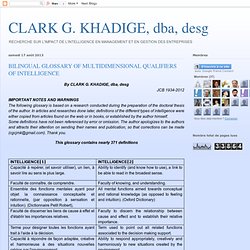
Birmingham Grid for Learning - Multiple Intelligences (Secondary) Multiple Intelligence Institute - MII. Emotional intelligence. Emotional intelligence (EI) can be defined as the ability to monitor one's own and other people's emotions, to discriminate between different emotions and label them appropriately, and to use emotional information to guide thinking and behavior.[1] There are three models of EI.
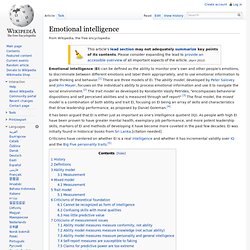
The ability model, developed by Peter Salovey and John Mayer, focuses on the individual's ability to process emotional information and use it to navigate the social environment.[2] The trait model as developed by Konstantin Vasily Petrides, "encompasses behavioral dispositions and self perceived abilities and is measured through self report" [3] The final model, the mixed model is a combination of both ability and trait EI, focusing on EI being an array of skills and characteristics that drive leadership performance, as proposed by Daniel Goleman.[4]
Emotional Intelligence Consoritum - Articles, Research and Information on Emotional Intelligence. Human Intelligence: biographical profiles, current controversies, resources for teachers. Contrasting and categorization of emotions. The contrasting and categorisation of emotions describes how emotions are thought to relate to each other.
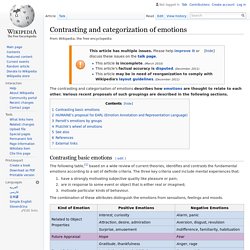
Various recent proposals of such groupings are described in the following sections. Contrasting basic emotions[edit] The following table,[1] based on a wide review of current theories, identifies and contrasts the fundamental emotions according to a set of definite criteria. The three key criteria used include mental experiences that: have a strongly motivating subjective quality like pleasure or pain;are in response to some event or object that is either real or imagined;motivate particular kinds of behaviour.
The combination of these attributes distinguish the emotions from sensations, feelings and moods. HUMAINE's proposal for EARL (Emotion Annotation and Representation Language)[edit] The emotion annotation and representation language (EARL) proposed by the Human-Machine Interaction Network on Emotion (HUMAINE) classifies 48 emotions.[2] Emotion classification. Emotion classification, the means by which one emotion is distinguished from another, is a contested issue in emotion research and affective science.
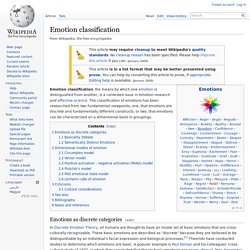
The classification of emotions has been researched from two fundamental viewpoints: one, that emotions are discrete and fundamentally different constructs; or two, that emotions can be characterized on a dimensional basis in groupings. Emotions as discrete categories[edit] The Limits of Intelligence. Santiago Ramón y Cajal, the Spanish Nobel-winning biologist who mapped the neural anatomy of insects in the decades before World War I, likened the minute circuitry of their vision-processing neurons to an exquisite pocket watch.
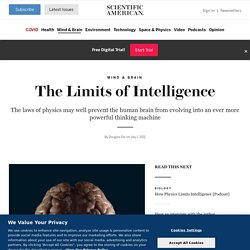
He likened that of mammals, by comparison, to a hollow-chested grandfather clock. Indeed, it is humbling to think that a honeybee, with its milligram-size brain, can perform tasks such as navigating mazes and landscapes on a par with mammals. A honeybee may be limited by having comparatively few neurons, but it surely seems to squeeze everything it can out of them. At the other extreme, an elephant, with its five-million-fold larger brain, suffers the inefficiencies of a sprawling Mesopotamian empire. Signals take more than 100 times longer to travel between opposite sides of its brain—and also from its brain to its foot, forcing the beast to rely less on reflexes, to move more slowly, and to squander precious brain resources on planning each step. Why an Intelligence Explosion is Probable. Richard Loosemore and Ben Goertzel One of the earliest incarnations of the contemporary Singularity concept was I.J.
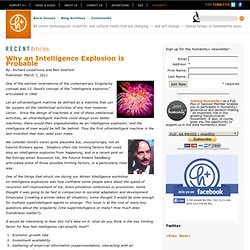
Good’s concept of the “intelligence explosion,” articulated in 1965: Let an ultraintelligent machine be defined as a machine that can far surpass all the intellectual activities of any man however clever. Power of Intelligence. In our skulls we carry around 3 pounds of slimy, wet, greyish tissue, corrugated like crumpled toilet paper.

You wouldn’t think, to look at the unappetizing lump, that it was some of the most powerful stuff in the known universe. If you’d never seen an anatomy textbook, and you saw a brain lying in the street, you’d say “Yuck!” And try not to get any of it on your shoes. Aristotle thought the brain was an organ that cooled the blood. It doesn’t look dangerous. Five million years ago, the ancestors of lions ruled the day, the ancestors of wolves roamed the night. Then came the Day of the Squishy Things. They had no armor. If you saw a movie of a nuclear explosion going off, and you were told an Earthly life form had done it, you would never in your wildest dreams imagine that the Squishy Things could be responsible. In the beginning, the Squishy Things had no fighter jets, no machine guns, no rifles, no swords. Chaos2000.pdf. Spiritual intelligence. Spiritual intelligence is a term used by some philosophers, psychologists, and developmental theorists to indicate spiritual parallels with IQ (Intelligence Quotient) and EQ (Emotional Quotient).
Danah Zohar coined the term "spiritual intelligence" and introduced the idea in 1997 in her book ReWiring the Corporate Brain.[1] Howard Gardner, the originator of the theory of multiple intelligences, chose not to include spiritual intelligence amongst his "intelligences" due to the challenge of codifying quantifiable scientific criteria.[2] Instead, Gardner suggested an "existential intelligence" as viable.[3] However, contemporary researchers continue explore the viability of Spiritual Intelligence (often abbreviated as "SQ") and to create tools for measuring and developing it. So far, measurement of spiritual intelligence has tended to rely on self-assessment instruments, which some claim can be susceptible to false reporting.
Definitions[edit] David B. Mi_concept_map.jpg (Image JPEG, 1609x999 pixels) - Redimensionnée (79%) INTELLIGENCES MULTIPLES. Spatial intelligence (psychology) Spatial Intelligence is an area in the theory of multiple intelligences that deals with spatial judgment and the ability to visualize with the mind's eye. It is defined by Howard Gardner as a human computational capacity that provides the ability or mental skill to solve spatial problems of navigation, visualization of objects from different angles and space, faces or scenes recognition or to notice fine details. Gardner further explains that Spatial Intelligence could be more effective to solve problems in areas related to realistic, thing-oriented, and investigative occupations.
This capability is a brain skill that is also found in people with visual impairment. Mi Oasis. Gardner´s+Multiple+Intelligences+Theory.jpg (Image JPEG, 1600x878 pixels) - Redimensionnée (80. Cultural intelligence. Cultural Intelligence, cultural quotient or CQ, is a term used in business, education, government and academic research.
Cultural intelligence can be understood as the capability to relate and work effectively across cultures. Originally, the term cultural intelligence and the abbreviation "CQ" was developed by the research done by Soon Ang and Linn Van Dyne as a researched-based way of measuring and predicting intercultural performance. The term is relatively recent: early definitions and studies of the concepts were given by P. Christopher Earley and Soon Ang in the book Cultural Intelligence: Individual Interactions Across Cultures (2003) and more fully developed later by David Livermore in the book, Leading with Cultural Intelligence..
The concept is related to that of Cross-cultural competence.[1] but goes beyond that to actually look at intercultural capabilities as a form of intelligence that can be measured and developed. Cultural Intelligence Center. Communication quotient. Communication quotient, communication intelligence, or CQ is a theory that communication is a behaviour based skill that can be measured and trained. CQ measures the ability of people to communicate effectively with one another. The first scholarly article referring to CQ was by Robert Service in CQ: the Communication Quotient for IS professionals. The article was published in 2005 in the Journal of Information Science.[1] In 2010 at TED Women, Clare Munn spoke about the importance of our Communication Quotient in an increasingly digital world.[2] History[edit]